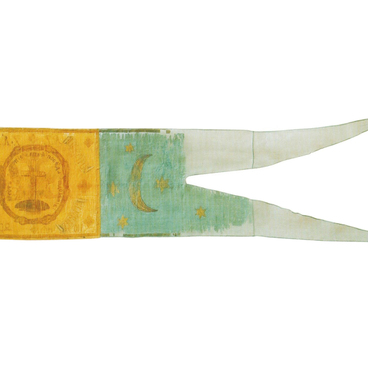Emperor Nicholas II granted the Banner of St. George to the First Khoper regiment of the Kuban Cossack Host in 1896. This unit was considered the oldest in the army: it was formed during the Azov campaigns of Peter the Great. The Khoper Cossack troops participated in the capture of the Azov fortress in 1696. From that date on, the history of the Kuban Cossack Host begins: in 1896, they celebrated their 200th anniversary in Ekaterinodar.
The banner of St. George is a two-layer rectangular cloth made of scarlet silk lined with thick white fabric. The length is 75 centimeters and the height is 69.
Three sides of the panel are trimmed along the edge with a silver border, along which there are ten eight-pointed stars. The same ornaments are embroidered in the corners. Along the perimeter, there is an inscription, ‘In memory of the two-hundred-year existence of the Kuban Cossack Host.’
In the center of the banner, Saint Alexander Nevsky is depicted on the golden background. An unknown artist painted him full-length with oil paints on the fabric. On the head of the saint is a princely hat denoting that during his lifetime Alexander Nevsky was the ruler. He holds a sword — a symbol of a warrior and defender of his native land.
The 200th anniversary of the Cossack Host was celebrated in September 1896. A special committee of 12 people was created to prepare the celebrations. On September 7, there was a solemn meeting of the banners granted by the emperor, including the banner of St. George of the Khoper regiment.
The main celebration was scheduled for September 8: it was intended for officers and officials of the Cossack host, as well as for guests from St. Petersburg. The Cossacks held a solemn parade, at which all the military regalia were presented. The granted banners were consecrated during a special prayer service. After that, a banquet for commanders, senior officers, and honored guests was held in the city garden. The combat units continued the celebrations in their camps.
A total number of 849 honored guests were invited to the celebration. These included members of the imperial family, atamans of all the Cossack troops, representatives of the Ministry of War, elected deputies from all the Cossack villages of Kuban.
The banner of St. George is a two-layer rectangular cloth made of scarlet silk lined with thick white fabric. The length is 75 centimeters and the height is 69.
Three sides of the panel are trimmed along the edge with a silver border, along which there are ten eight-pointed stars. The same ornaments are embroidered in the corners. Along the perimeter, there is an inscription, ‘In memory of the two-hundred-year existence of the Kuban Cossack Host.’
In the center of the banner, Saint Alexander Nevsky is depicted on the golden background. An unknown artist painted him full-length with oil paints on the fabric. On the head of the saint is a princely hat denoting that during his lifetime Alexander Nevsky was the ruler. He holds a sword — a symbol of a warrior and defender of his native land.
The 200th anniversary of the Cossack Host was celebrated in September 1896. A special committee of 12 people was created to prepare the celebrations. On September 7, there was a solemn meeting of the banners granted by the emperor, including the banner of St. George of the Khoper regiment.
The main celebration was scheduled for September 8: it was intended for officers and officials of the Cossack host, as well as for guests from St. Petersburg. The Cossacks held a solemn parade, at which all the military regalia were presented. The granted banners were consecrated during a special prayer service. After that, a banquet for commanders, senior officers, and honored guests was held in the city garden. The combat units continued the celebrations in their camps.
A total number of 849 honored guests were invited to the celebration. These included members of the imperial family, atamans of all the Cossack troops, representatives of the Ministry of War, elected deputies from all the Cossack villages of Kuban.



